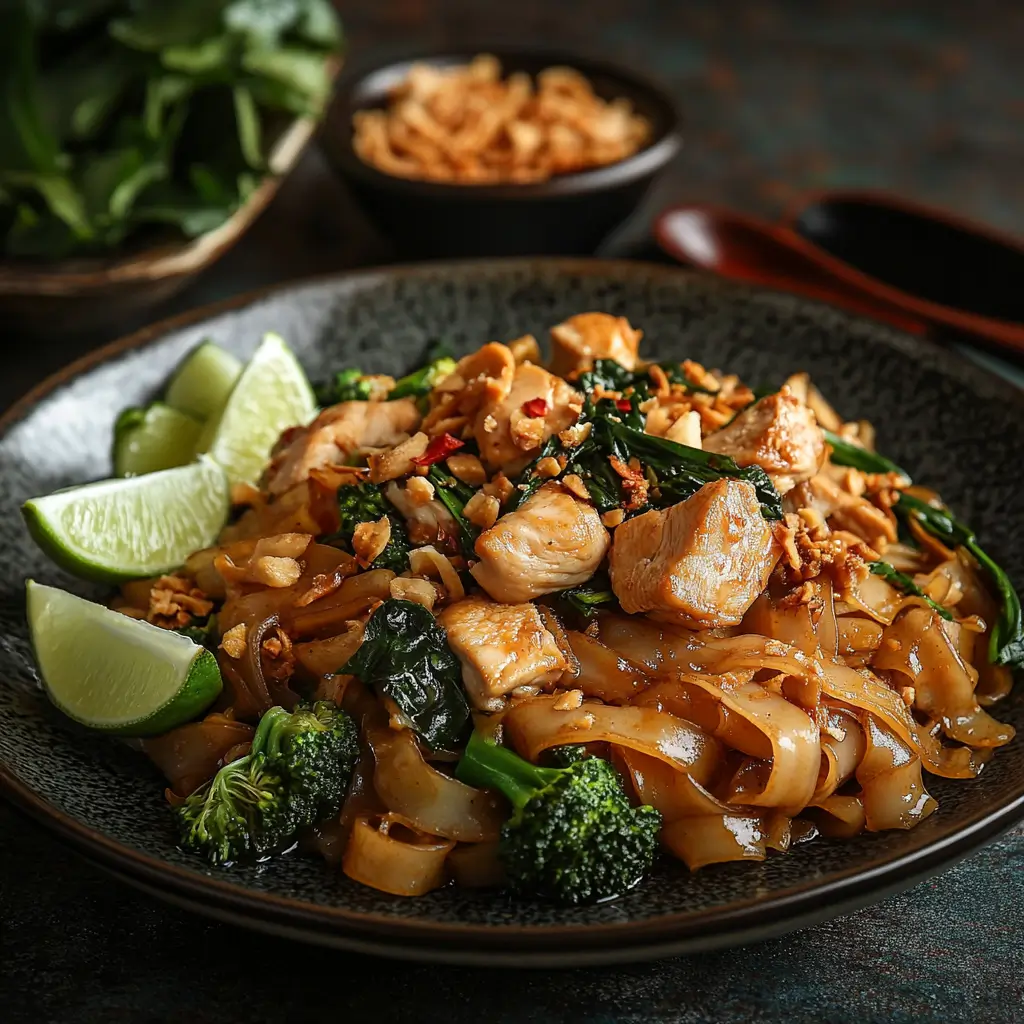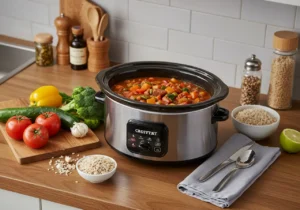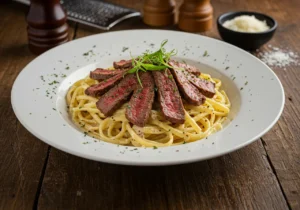Introduction to Phat Si-Io Recipe
If you’re craving something bold, savory, and utterly satisfying, then you must try a phat si-io recipe (also known as Pad See Ew). This popular Thai dish combines chewy wide rice noodles, succulent protein, crunchy Chinese broccoli, and a flavorful sauce that hits all the right notes of sweet, salty, and umami. It’s a dish that’s been passed down through generations and has become a staple in street food culture across Thailand. But you don’t need to fly to Thailand to enjoy this mouthwatering dish—today, we’re going to break down the process step-by-step, so you can easily recreate this dish at home.
From the essential ingredients to tips and tricks on getting the perfect char, we’ll guide you through everything you need to know to make your own authentic phat si-io. Whether you’re a seasoned chef or just starting out, this guide will help you achieve that perfect stir-fry every time.
Let’s dive into the details of this delicious Thai street food favorite.
Essential Ingredients for Phat Si-Io Recipe
Before you fire up that wok, let’s take a look at the ingredients that will bring this dish to life. The phat si-io recipe isn’t just about the noodles—it’s the combination of fresh vegetables, protein, and a savory sauce that gives it its irresistible flavor.
Key Components and Their Roles
- Wide Rice Noodles (Sen Yai): The heart of any phat si-io recipe lies in the wide rice noodles. These chewy, slippery strands are what define the texture of this dish. When stir-fried, they absorb all the savory goodness from the sauce, giving each bite a satisfying chew. Fresh noodles are the best option, but if you can’t find them, dried rice noodles can work as well—just make sure they’re soaked properly before stir-frying.
- Protein Choices: Whether you prefer chicken, beef, shrimp, or tofu, the protein is another key ingredient in your phat si-io recipe. Typically, this dish uses thinly sliced meat, but for those who are vegetarian or vegan, tofu is a great alternative. The protein should be marinated with a little soy sauce and sugar, which helps infuse flavor and tenderize it as it cooks.
- Chinese Broccoli (Gai Lan): No phat si-io Recipe is complete without gai lan or Chinese broccoli. This vegetable adds a slight bitterness that beautifully balances the richness of the sauce. Its crispy stems and tender leaves bring both texture and freshness to the dish. If you can’t find gai lan, feel free to substitute with regular broccoli or bok choy, though the flavor won’t be quite the same.
- Eggs: Eggs are another essential ingredient, adding a bit of richness to the dish. They’re scrambled into the stir-fry, binding the noodles and other ingredients together. You can adjust the number of eggs to your preference, but they add both flavor and texture to the dish.
Sauce Ingredients and Their Flavor Contributions
- Dark Soy Sauce: Dark soy sauce is crucial for giving phat si-io its characteristic deep brown color and robust flavor. It’s richer and slightly sweeter than regular soy sauce, so be sure to include it in your phat si-io recipe.
- Light Soy Sauce: Unlike dark soy sauce, light soy sauce is saltier and used to season the dish. It adds a more pronounced salty note that complements the sweetness of the dark soy sauce.
- Oyster Sauce: Oyster sauce is what gives phat si-io recipe that umami-packed savory punch. It’s a must-have for creating the perfect stir-fried noodles that are both rich and deeply flavorful.
- Sugar: Yes, sugar! It might sound odd to add sugar to a savory stir-fry, but in the case of phat si-io, it helps balance the salty and savory flavors of the soy and oyster sauces. The sweetness also caramelizes the noodles, helping them develop a slight char.
- White Pepper: Finally, a bit of white pepper adds a subtle heat that rounds out the flavor profile of the dish. You don’t need a lot, just enough to give it that extra kick.
Now that you know the key ingredients, you’re ready to get cooking. In the next section, we’ll go over the preparation process to ensure your phat si-io recipe turns out perfectly every time.
Preparing the Ingredients for Phat Si-Io Recipe
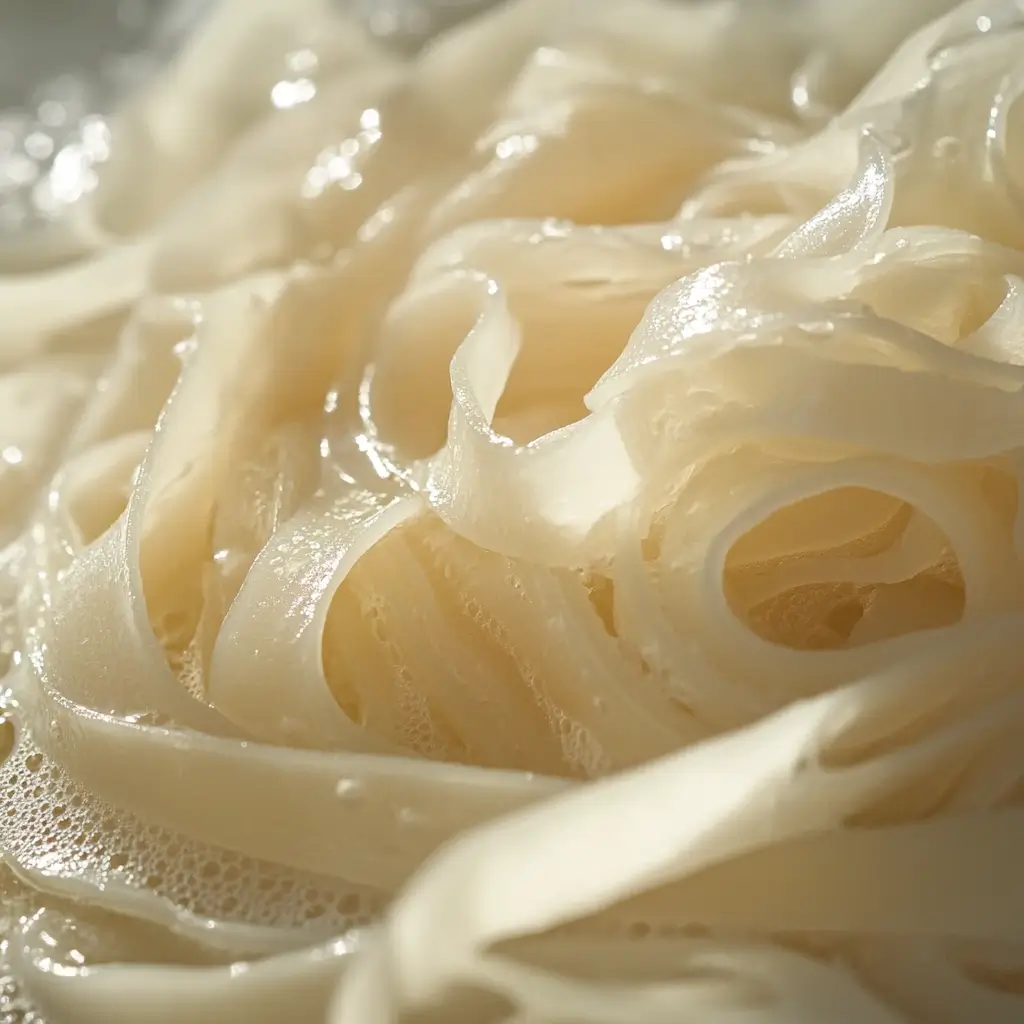
Now that you know what goes into the dish, let’s talk about how to get everything ready. Preparation is key to making sure your phat si-io recipe comes together smoothly. The right prep work will save you time when you’re cooking and ensure that each ingredient is properly incorporated.
Selecting and Preparing the Noodles
When making a phat si-io recipe, it’s important to choose the right kind of rice noodles. As mentioned earlier, fresh wide rice noodles (sen yai) are the best choice because of their chewy texture. If you’re using dried noodles, be sure to soak them until they’re soft but not too mushy. Soaking them for about 30 minutes should be enough. However, you don’t want them overly soaked, as this can make them too limp when stir-frying. After soaking, rinse them under cold water to prevent them from sticking together.
In addition, make sure to separate the noodles before cooking. This prevents clumping and ensures they fry evenly when added to the wok.
Marinating the Protein for Enhanced Flavor
Whether you’re using chicken, shrimp, or tofu, marinating the protein is a crucial step in this phat si-io recipe. The marinade, which typically consists of light soy sauce and a touch of sugar, not only seasons the protein but also helps tenderize it. Allow the protein to sit in the marinade for at least 15 minutes before cooking. This will help the flavors soak in, giving you a tastier and more flavorful stir-fry.
If you’re using tofu, pressing out any excess water is also a good idea. This helps the tofu absorb more flavor from the sauce and allows it to crisp up nicely when stir-fried.
Chopping Vegetables and Other Preparations
The last thing to prep is the Chinese broccoli (gai lan). You’ll want to slice the stems into shorter pieces since they take longer to cook than the leaves. Once chopped, the leaves can be left whole or cut into smaller pieces, depending on your preference. If you can’t find gai lan, feel free to swap in regular broccoli or bok choy, but keep in mind that the flavor won’t be exactly the same. Having everything ready to go before you start cooking is crucial to a smooth, quick stir-fry.
Cooking Phat Si-Io Recipe: Step-by-Step Guide
Now, it’s time for the fun part: cooking your phat si-io recipe. The key here is high heat, a good wok, and plenty of stirring action. Let’s break it down step-by-step.
Stir-Frying the Protein and Vegetables
To begin, heat a bit of oil in a wok over medium-high heat. Once hot, add the marinated protein and stir-fry it until it’s almost cooked through. If you’re using chicken, you’ll want to make sure it’s cooked thoroughly. For shrimp, it only takes a minute or two until they turn pink.
Next, add the Chinese broccoli stems first, followed by the leaves. The stems will take longer to cook, so adding them first ensures that everything gets cooked evenly. Stir-fry the vegetables and protein together until the stems are tender and the leaves are bright green and slightly wilted.
Incorporating the Noodles and Achieving the Signature Char
Once your protein and vegetables are cooked, it’s time to add the noodles. Push everything to the side of the wok and pour in a little more oil. Then, add the rice noodles to the pan. Let them sit undisturbed for a minute or two to allow them to develop a slight char. This step is what gives the phat si-io recipe its signature smoky flavor.
Once the noodles have a little color, start stirring them together with the protein and vegetables. This is where the magic happens: all the flavors meld together as you toss everything in the wok.
Adding the Sauce and Balancing Flavors
In a small bowl, mix together your dark soy sauce, light soy sauce, oyster sauce, and sugar. Pour this sauce mixture over the noodles and toss everything together. The noodles should absorb all the savory goodness of the sauce, coating each strand. If needed, you can adjust the seasoning at this point by adding more soy sauce or a pinch of sugar to balance the flavors.
At this stage, crack an egg directly into the pan and scramble it with the noodles. The egg will bind the noodles together and add a rich, silky texture to the dish. Once the egg is cooked, your phat si-io Recipe is almost ready!
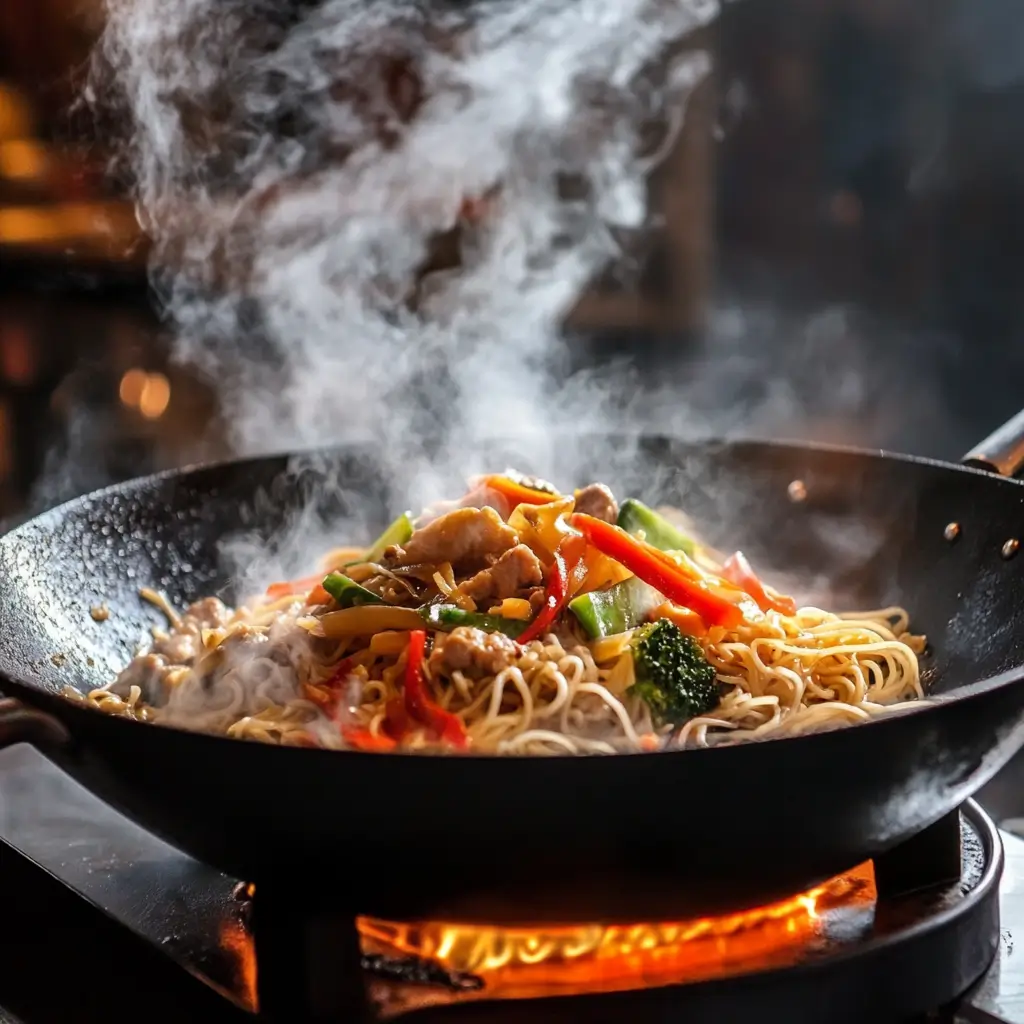
Tips and Tricks for the Perfect Phat Si-Io Recipe
If you want your phat si-io recipe to be as close to perfection as possible, here are a few tips and tricks to keep in mind. These will help ensure that your stir-fry turns out just like the ones you find at your favorite Thai restaurant.
Achieving the Desired Noodle Texture
To get the perfect texture for your rice noodles, you need to avoid over-soaking them. If the noodles are too soft when they hit the wok, they’ll become mushy during stir-frying. Therefore, it’s important to soak them just enough to soften them but not so much that they lose their structure. If using dried noodles, rinse them under cold water to stop the cooking process after soaking.
Managing Heat Levels for Optimal Cooking
A key aspect of stir-frying is maintaining high heat. Stir-frying over high heat allows the ingredients to cook quickly, which helps them retain their texture and flavor. On the other hand, cooking on low heat will lead to steaming, and that’s not what you want for a phat si-io recipe. A wok or a large frying pan works best here because it ensures that the ingredients cook quickly and evenly.
Common Mistakes to Avoid When Cooking Phat Si-Io Recipe
Cooking a perfect phat si-io recipe might seem simple, but there are a few pitfalls you’ll want to avoid. Here are some common mistakes people make when preparing this Thai dish and how to prevent them.
Overcrowding the Wok
One of the most common mistakes when making phat si-io is overcrowding the wok. When you add too many ingredients to the pan at once, the temperature of the wok drops. This prevents the noodles from getting that signature smoky char and leads to steaming, which can leave your stir-fry soggy instead of crispy.
Therefore, it’s important to cook in batches if necessary. If you have a large amount of ingredients, cook them in stages, adding the protein, vegetables, and noodles separately. This will ensure that each component gets cooked properly and retains its texture.
Using the Wrong Type of Noodles
The noodles are the star of any phat si-io recipe, so using the wrong type can significantly affect the dish. You should use wide rice noodles (sen yai) for the best texture and flavor. If you’re using dried noodles, make sure to soak them properly—too little soaking and they’ll be too tough, too much and they’ll become mushy when stir-fried.
To avoid this, always opt for fresh noodles if available. They’ll give you that perfect chewy texture that makes phat si-io so satisfying. If using dried noodles, soak them for about 30 minutes before cooking and rinse them with cold water.
Not Achieving the Right Stir-Fry Char
Another mistake many home cooks make is not getting the stir-fry char right. The smoky, slightly caramelized flavor from the high heat is what makes phat si-io so irresistible. To achieve this, make sure your wok or pan is hot before you add the ingredients. If it’s not hot enough, the noodles won’t get that beautiful char, and the dish will lack that depth of flavor.
Serving and Enjoying Your Phat Si-Io
Now that you’ve made your delicious phat si-io, it’s time to enjoy it! This stir-fry is often served hot off the wok and is perfect for a quick weeknight dinner or a special occasion. To elevate the dish and add an extra burst of flavor, here are a few serving tips.
Garnishing and Adding Extra Flavor
While phat si-io is already packed with flavor, you can always enhance it with a few finishing touches. A squeeze of fresh lime juice on top adds a tangy kick that balances the richness of the dish. Some fresh cilantro or Thai basil also pairs wonderfully with the stir-fry, giving it an aromatic freshness. You can even sprinkle a little chili flakes or chopped peanuts for some heat and crunch.
If you’re a fan of spice, serve your phat si-io with some fresh sliced bird’s eye chilies on the side. These small but potent chilies pack a punch and are perfect for those who like to turn up the heat.
Pairing with Side Dishes
For a complete Thai meal, you can serve phat si-io alongside some other Thai favorites. A simple Thai soup, like tom yum or tom kha gai, complements the stir-fry perfectly, as the spicy, sour soup contrasts beautifully with the savory noodles. You could also serve it with a refreshing green papaya salad (som tam) for an extra crunch and zing.
For more delicious recipes, check out our Exploring the Best Iranian Recipes.
FAQs About Phat Si-Io Recipe
1. What is Phat Si-Io?
Phat si-io (also known as Pad See Ew) is a popular Thai stir-fry dish made with wide rice noodles, a savory soy-based sauce, and your choice of protein (such as chicken, beef, shrimp, or tofu), along with Chinese broccoli (gai lan). It’s known for its smoky flavor, achieved by stir-frying the ingredients over high heat, and its balance of sweet, salty, and umami flavors.
2. Can I make Phat Si-Io vegetarian or vegan?
Absolutely! You can easily make a vegetarian or vegan phat si-io recipe by replacing the animal protein with tofu, tempeh, or more vegetables. Just be sure to use vegan oyster sauce or mushroom sauce as a substitute for traditional oyster sauce to maintain the dish’s rich flavor.
3. What kind of noodles should I use for Phat Si-Io?
For the best results, use sen yai (wide rice noodles), which are chewy and perfect for stir-frying. If you can’t find fresh rice noodles, dried ones can be used—just soak them properly to ensure they don’t become too soft when stir-fried.
4. How do I get the smoky flavor in Phat Si-Io?
The key to getting that signature smoky flavor is to stir-fry the noodles over high heat. Let them sit undisturbed in the wok for a minute or two to allow them to develop a slight char. This is what gives the dish its authentic, smoky taste.
